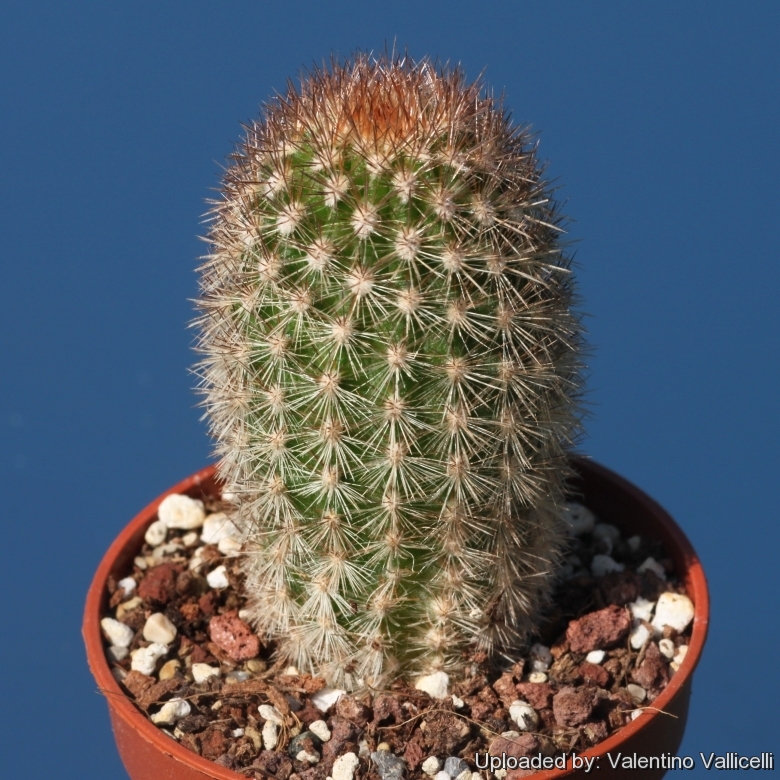= Oreocereus rettigii (Quehl) Buxb.
in Kakteen. 55-56. CVc (1973).
Accepted Scientific Name: Oreocereus hempelianus (Gürke) D.R.Hunt
Bradleya 5: 93 (1987)

Borzicactus hempelianus var. rettigii (Oreocereus rettigii) Photo by: Valentino Vallicelli
Origin and Habitat: Mountains of South Peru (Arequipa) and adjacent areas in north Chile
Altitude range: Around 1,500 to 3,000 metres above sea level.
Habitat and ecology: The species grows in Andean shrubland on rocky and sandy soils where is grows in isolated patches and is locally abundant. Weberbaaeroccreus weberbaueri and Tephrocactus sphaericusSN|4201]]SN|4201]] are also found here.
Synonyms:
See all synonyms of Oreocereus hempelianus
back
Accepted name in llifle Database:Oreocereus hempelianus (Gürke) D.R.HuntBradleya 5: 93 (1987)Synonymy: 29
back
Common Names include:
RUSSIAN (Русский): Арекипа Реттига
SPANISH (Español): Achacaño, Arequipa
Description: Oreocereus rettigiiSN|3798]]SN|3816]] (Quehl) Buxb. (firstly described as Echinocactus rettigiiSN|3812]]SN|3812]] Quehl by Quehl in 1919) is a local or morphological form of the widespread and variable Oreocereus hempelianusSN|3798]]SN|3798]]. It is covered with many coloured spines and has tubular red flowers with oblique edges and spiny bases. The plants grow in isolated patches with hairy branches about 30 cm high. Old reclining stems at times attain a length of a meter. Flowers and mature fruits are often found together. The plant is quite variable but probably consists of a single species with many forms and its characteristics appear to fall within the natural variation of Oreocereus hempelianusSN|3816]]SN|3798]], so it should be synonymized with the latter. The several varieties that have been described are forms of the same species.
Bibliography: Major references and further lectures
1) Cactaceas y suculentas mexicanas, Volumi 9-16, page 98 Sociedad Mexicana de Cactología., 1964
2) James Cullen, Sabina G. Knees, H. Suzanne Cubey "The European Garden Flora Flowering Plants: A Manual for the Identification of Plants Cultivated in Europe, Both Out-of-Doors and Under Glass" Cambridge University Press, 11/Aug/2011
3) David R Hunt; Nigel P Taylor; Graham Charles; International Cactaceae Systematics Group. "The New Cactus Lexicon" dh books, 2006
4) Urs Eggli, Leonard E. Newton: “Etymological Dictionary of Succulent Plant Names” Springer, Berlin/Heidelberg 2010
5) Willy Cullmann, Erich Götz (Dozent Dr.), Gerhard Gröner “The encyclopedia of cacti” Timber Press, 1987
9) Edward Anderson “The Cactus family” Timber Press, Incorporated, 2001
10) Cáceres, F., Faundez, L., Guerrero, P., Saldivia, P. & Walter, H.E. 2013. Oreocereus hempelianus. In: IUCN 2013. "IUCN Red List of Threatened Species." Version 2013.2. <www.iucnredlist.org>. Downloaded on 05 December 2013.
Cultivation and Propagation: This is a a much decorative frost hardy cactus easily found in cultivation.
Soil: Grow it in a rich and particularly draining substratum, as it is very sensitive to rottenness when in presence of humidity and low temperatures and let the soil dry out between waterings.
Water: In summer, during the vegetative period, it must be regularly watered, but allowing the substratum to completely dry up before irrigating again; in winter, it’s to be kept dry. Preferable not to water on overcast days, humid days or cold winter days.
Hardiness: Hardy to -7°, but tolerate temperatures down to -12° C for short periods if very dry. However in cultivation it is better not to expose it to below zero temperatures, especially if in presence of high atmospheric humidity as it is particularly sensitive to root rot. However in cultivation it is better not to expose it to temperatures lower than -5° C, even if in an aerated and protected location, in order to avoid the formation of anti-aesthetic spots on the epidermis.
Exposure: It need full sun exposures with ample airflow to produce dense hairs, but, as a former mountain dweller, does not care for extremely high temperatures in summer.
Maintenance: Repot in the spring, when their roots become cramped. Generally, they should be repotted every other year in order to provide fresh soil. After repotting, do not water for a week or more.
Use: Excellent as landscape or patio plant. It is suitable for small “desert” gardens, in association with other xerophytes. Where the open air cultivation is not possible due to the climate, it is to be cultivated in pot in order to shelter it in winter.
Propagation: By seeds and by cuttings, provided left drying up well, in summer.











